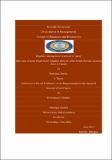| dc.description.abstract | The issue of food security is a serious concern especially in arid and semi-arid regions like
Tigray, which is vulnerable to climatic instability and frequent droughts. To see the positive
effect of irrigation on livelihood, the management aspect of irrigation must be taken in to
account. Nevertheless, the management aspect of irrigation is often neglected while priorities are
given to the construction of irrigation. Therefore, the purpose of this study has been to assess
irrigation management practices with special reference to Qorir Small Scale Irrigation Scheme,
Klite-Awlalo Woreda, Eastern Zone of Tigray, Ethiopia. The study has been focused on
examining how users were organized for self-management of the scheme and how water
management, conflict management, operation and system maintenance issues were practiced and
challenges that hinder the sustainability of the scheme also included in the study. In order to
undertake this study, household questionnaire, focus group discussion, interview and key
informant interview were carried out to collect primary data from all beneficiaries of the scheme.
Both quantitative and descriptive analysis techniques were used for analyzing the data. In
addition, relevant literatures and essential documents were reviewed that was useful for the
study. The findings of this study showed that the water committee is responsible for water
allocation and distribution, coordinating maintenance activities and conflict management in the
irrigation scheme with support from development agents and extension workers. Nonetheless, the
water committee in the irrigation scheme is found to be inefficient in managing water distribution
in terms of adequacy, timeliness and equity in the supply of water. The study result also revealed
that conflict within and between groups was persistent due to water scarcity, water theft, lack of
proper control of water distribution and competition (increasing number of users). Although the
dam was meant to irrigate hundred hectares of the vast command area along the downstream, it
irrigates about 50 hectares on average and that is small as compared to the expected potential of
the irrigation scheme. This is because a significant number of beneficiaries (61.7%) faced a
problem of water shortage for their agricultural activities. | en_GB |


